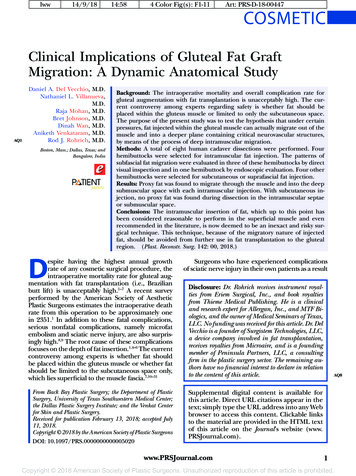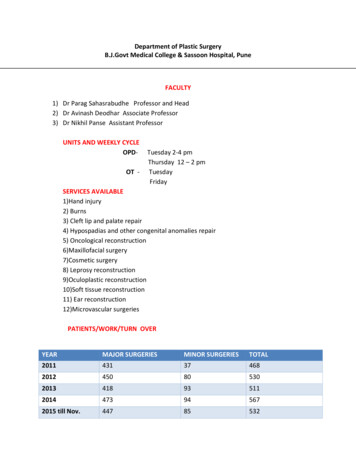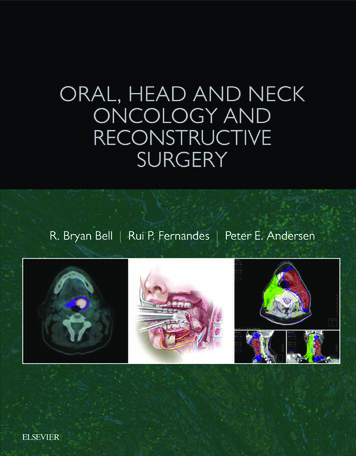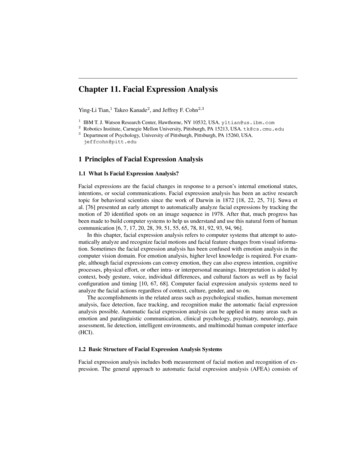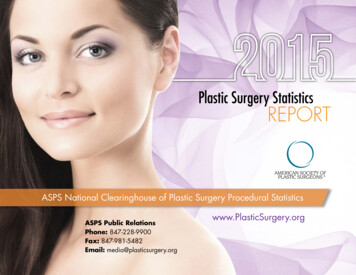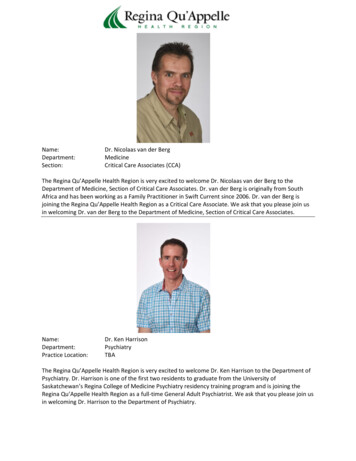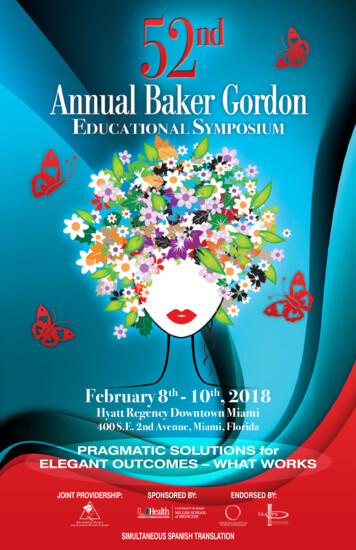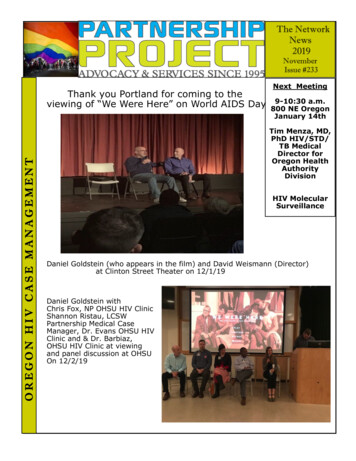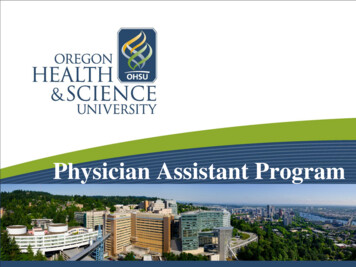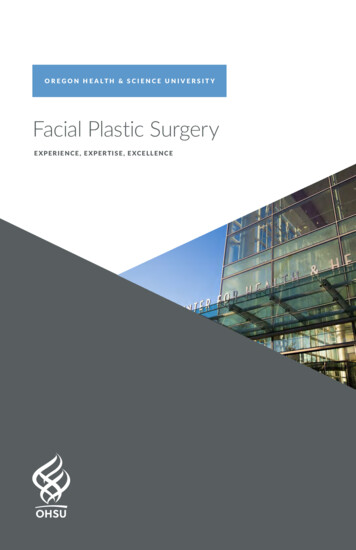
Transcription
O R E G O N H E A LT H & S C I E N C E U N I V E R S I T YFacial Plastic SurgeryE X P E R I E N C E , E X P E R T I S E , E XC E L L E N C E
ContentsIntroduction Our providers 5Considerations for surgery 8Risks of facial plastic surgery 8Medical photographs 10Anesthesia 10Finances and insurance 10What facial plastic surgery entails 11The consultation 11Subsequent pre-surgery visits 12Preparing for surgery 12Day of surgery 13Postoperative care 14Procedure descriptions 23Introduction15This booklet is designed to acquaint you with ourservices and to let you know what to expect fromfacial plastic surgery. As you read, write down anyquestions you have so we may discuss them duringyour consultation.Rhinoplasty: creating the nose you always wanted 15Mentoplasty: creating facial balance through chin augmentation 15Malar augmentation: highlighting the cheeks 16Protruding ears: making them inconspicuous 16Facial liposculpture 16Facelift surgery: a younger-looking you 16Browlift surgery: an upper facelift 17Blepharoplasty: creating less-tired eyes 18Facial skin resurfacing: freshening tired skin 18Broadband light treatment 19largely elective, you are allowed adequate time to thoroughly understand theNeuromodulator injections (Dysport or Botox) 20details and consequences of any desired procedure. It is our intention to ensureSoft tissue filler injections 20Scar revision 20Excision: removing skin cancers and moles 21Reconstruction of facial skin defects 21The decision to undergo facial plastic surgery is a very personal andimportant one, requiring mutual understanding and communication betweenyou and your surgeon. Fortunately, because this form of plastic surgery isthat all of your questions are answered completely, and that you approachsurgery with the confidence and expectations born of a realistic understandingof the goals and limitations of surgery.The degree of success depends not just upon the surgeon’s technical skillsand analysis, but also upon the limitations inherent in your skin type, boneList of medications to discontinue prior to surgery 21structure, healing capacity and overall health status. If any limitations exist inIn conclusion 24your case, such limitations will be pointed out and discussed with you factually3
and honestly. Certain people are simply not good candidates for surgery andmay be understandably disappointed when plastic surgery is not recommendedor is delayed until a more appropriate time when results might be improved.The goal of cosmetic surgery is to make you look as good as it is possibleOur providersTom D. Wang, M.D., F.A.C.S.for you. We always try to produce “natural” facial features, which improveDr. Tom Wang is the director ofappearance and minimize facial abnormalities. The various proceduresfacial plastic and reconstructivediscussed in this booklet are in reference to the average case; individualsurgery at OHSU. Dr. Wang hasvariations certainly exist.been a full-time member of theThis booklet will provide you with information and knowledge to help youfacial plastic surgery division sincemake an informed decision. No portion of this booklet should be construed1993 and has performed more thanas implying a warranty or guarantee of any specific surgical result. Cosmetic10,000 procedures. He is widelysurgical procedures have been performed successfully many thousands of timespublished in medical literature andand are overwhelmingly dependable when executed by experienced surgeons.is internationally recognized asHowever, as with any surgical procedure, there is potential for risks andan innovative teacher and leadercomplications. These will be discussed in detail during your consultation.on the latest techniques in facialplastic surgery.Dr. Wang is past president of theAmerican Academy of Facial Plasticand Reconstructive Surgery. Thisgreat honor represents recognitionof Dr. Wang’s accomplishmentsand commitment to advancingthe specialty of facial plastic andreconstructive surgery for bothpatients and surgeons.Dr. Wang’s practice is limitedexclusively to cosmetic andreconstructive surgery of theface. His areas of expertise“My philosophy in facial cosmeticsurgery is to create natural,balanced results for each patient.My main areas of interest in facialcosmetic surgery are in rhinoplastyand facial rejuvenation, includingendoscopic facial procedures. I feelthat limiting my practice exclusivelyto facial plastic surgery allows meto emphasize and refine the art offacial cosmetic surgery and take itto a higher level.”include rhinoplasty (cosmeticand functional nasal surgery), rhytidectomy (face and neck lift, brow lift),blepharoplasty (eyelid tuck, ptosis repair), otoplasty (correcting protruding ears,earlobe repair), reconstruction of facial defects following skin cancer removal(Mohs), scar revision, benign and malignant facial skin lesion removal, cleft lipand palate repair, microtia repair (correcting malformed ears) and minimallyinvasive aesthetic procedures (injectable fillers, neurotoxins, skin resurfacing).Over the past 20 years, Dr. Wang has volunteered and led humanitariantrips to many parts of the globe, treating children with cleft lip and other facialproblems. This represents his ongoing commitment to help serve those in need.45
Michael M. Kim, M.D.Myriam Loyo Li, M.D.Dr. Michael Kim is a proud nativeDr. Myriam Loyo Li is a facialof the Pacific Northwest. He grewplastic surgeon with advancedup in Bellevue, Washington andtraining in facial reconstructionearned his bachelor’s degree inand cosmetic surgery.molecular biology from PrincetonShe completed her surgicalUniversity. He completed histraining in otolaryngology-head andmedical education at the Universityneck surgery at the Johns Hopkinsof Washington and subsequentlyHospital and further specializationmoved to Baltimore, Marylandin facial plastic and reconstructivewhere he did his internshipsurgery at OHSU. Dr. Loyo Li offersin surgery and residency inthe latest procedures for the face,otolaryngology - head andranging from minimally-invasiveneck surgery at Johns Hopkinsinjectable and lasers to traditionalUniversity. Further subspecialtysurgery. She also has a specialtraining in facial plastic andexpertise in the management ofreconstructive surgery and“I believe that one of my greatestcomplex facial nerve injuries. Dr.“I will customize each treatmentLoyo Li has published numerousto reflect your unique needs andto communicate with patients andtextbook chapters and peer-specific facial traits, skin condition,include them as active participantsreviewed articles.oculoplastic surgery was completedstrengths as a physician is my abilityat OHSU.Dr. Kim then joined the faculty ofMayo Clinic Arizona’s Departmentin their treatment planning andof Otolaryngology. After two yearspostoperative care. Patients canrhinoplasty (cosmetic andaesthetic concerns and lifestyle.My goal is to work together toenhance your natural beauty andof practice, Dr. Kim returned totrust that my focused expertise infunctional nasal surgery), faceliftreduce unfavorable traits or signsthe Northwest where he joinedall aspects of Facial Plastic Surgery(including mini-lifts and neckof aging so that you can achievethe Division of Facial Plastic andwill enable us to achieve the bestlifts), brow lift and blepharoplastybeautiful and completely naturalReconstructive Surgery at OHSUpossible results together.”(for upper and lower eyelids),results.”in 2011.Dr. Kim’s practice is highlyreconstruction of facial defectsfollowing skin cancer removalspecialized, focusing exclusively on(Mohs), chin reduction and chinplastic surgery of the face, head and neck. He is board-certified by the Americanimplant surgery, scar revision (including keloids), mole and other benign skinBoard of Otolaryngology - Head and Neck Surgery and the American Board oflesion removals, laser resurfacing and light therapy to the face for pigmentedFacial Plastic and Reconstructive Surgery. His areas of expertise include nasallesions, otoplasty (correcting protruding ears), earlobe and gauged ear repair,surgery (aesthetic and functional septoplasty/rhinoplasty), facial rejuvenationfacial feminization surgery (FFS), skin care and minimally invasive injectables(facelift, necklift, browlift), oculoplastic surgery (blepharoplasty, ptosis(such as Botox, Dysport, fillers and injection lipolysis). For the treatment ofrepairs), laser facial skin resurfacing, facial reconstruction following skinfacial paralysis, Dr. Loyo Li performs suspensions to improve symmetry as wellcancer surgery (Mohs reconstruction), scar revision, otoplasty (ear pinning),as nerve and muscle transfers to restore smiles.earlobe repair, benign and malignant skin lesion removal, and minimallyinvasive aesthetic procedures (injectable fillers and neuromodulators).In his free time, Dr. Kim enjoys spending time with his family, playing golf,attending sporting events, and trying new restaurants.6Her areas of expertise includeDr. Loyo Li is originally from the Pacific coast of Mexico. She and her husband,Ryan Li, a head and neck and microvascular surgeon, enjoy cooking togetherand spending time in the beautiful outdoors of Oregon. They also participate inhumanitarian surgical mission trips to Latin America and Africa.7
Kay FordLICENSED ESTHETICIANKay studied facial technology inPortland, Oregon. Her advancedtraining started at the AmericanInstitute of Esthetics, HuntingtonBeach, California. Kay hascontinued her advanced trainingwith internationally recognizedskincare lines and pharmaceuticalproducts. Currently, she worksunder the direction of Drs. TomWang, Michael Kim, and MyriamLoyo Li in the Division of FacialPlastic and Reconstructive Surgeryat OHSU. As a native Oregonian,Kay loves everything about ourarea, even the rain. She lovesspending time with her family,going to Broadway musicals, concerts, movies and dining.Kay’s services include skin analysis, customized skin care, therapeutic facialsand chemical peels from PCA SKIN , the ZO Medical 3-Step-Stimulation Peel and the DiamondTome Peel . Chemical peels use a solution that incorporatesnaturally occurring acids with strengthening and brightening ingredients toConsiderations for surgeryFacial plastic surgery is geared toward improvement in the appearance of yourface. Any plastic surgery should be regarded as a way to make an unfavorablefacial feature aesthetically pleasing or less conspicuous. An improvedappearance often results in increased self-satisfaction and self-confidence.Facial plastic surgery can greatly help in minimizing the psychological stressdue to unfavorable physical characteristics such as protruding ears, oversizednoses, birthmarks, and a host of facial blemishes, sags, wrinkles and scars.Plastic surgery, however, is not intended to serve as a cure-all for other lifechallenges. Those who expect miracles from facial plastic surgery are likely tobe disappointed. From the perspective of aesthetic results, improvement is amore realistic goal than is perfection.As noted earlier, results will depend not only on the skill and experienceof the surgeon, but also on many other factors. These can include the health,age, bone structure, skin texture, healing capacity and specific concerns of thepatient. Some people, because of these variables and because of psychologicalconsiderations, are not appropriate candidates for plastic surgery.No surgical procedure should be taken lightly. A slight, but real risk isinvolved in any surgical procedure. While it is extremely uncommon, reactionscan occur. Our team of surgeons and staff are specifically trained to preventproblems and improve results for our patients.Risks of facial plastic surgeryEvery surgical procedure involves some degree of risk. Risk is defined in termsexfoliate surface dead skin cells. Peels are effective in reducing surface wrin-of possible complications, disappointments or surgical results which maykles, sun damage and clearing acne/blemished skin. PCA Advanced Skin Carenot match one’s expectations. Although quite rare, other risks may includeSystems, ZO Medical and ZO Skin Health Products and Jane Iredale productsreactions to medications or anesthesia, bleeding, infection, poor healing,are available for purchase through Kay’s practice.numbness, swelling, injuries to muscles or nerves, discoloration of tissues,scarring and even death.You should be aware of these possibilities and are encouraged to inquire aboutthe realistic risks associated with the contemplated procedure. We also encourageTo receive your individualized skin maintenance advice, make anappointment with Kay, order products, or receive information aboutany of the other services Kay provides, please call 503 494-5678.Kay sees patients at the OHSU Center for Health and Healing at theSouth Waterfront. Our products are available through the office or bymail order.you to discuss any concerns with the surgeon in advance. To reduce the risksinherent in any surgical procedure, our surgical team works closely with qualifiedprofessionals in all areas of expertise throughout OHSU to ensure that our patient’sexposure to risk is minimized.Our operating rooms and recovery rooms are staffed by registered nurses.These nurses are extensively trained and experienced in all aspects of facialplastic and reconstructive surgery patient care, from preoperative discussionsto postoperative care. They continue to attend courses to keep their skills andknowledge updated and are trained in the latest emergency care procedures.89
AnesthesiaThe best and safest form of anesthesia will be provided to you for yourprocedure. This may involve general anesthesia attended by a staffanesthesiologist, depending on your surgery. We also occasionally use “twilight”intravenous anesthesia for some procedures. You may receive preoperativemedications to help you relax before going in the operating room. All of ouranesthetics are administered with the intent to provide the utmost in patientsafety and comfort, as well as facilitate the recovery process following yourprocedure. A local anesthetic is also used to directly numb the area of surgery.During all but the most minor procedures, a skilled anesthesiologist is activelyinvolved in ensuring your comfort and medical safety during the operation andin the postoperative recovery period.Finances and insuranceWe will discuss all fees and provide a written estimate of the charges foryour procedure during your first consultation visit. We have developed, inconjunction with OHSU, a package price for our patients which includes theAnesthesia services are provided by licensed anesthesiologist physicians.The majority of our surgery is performed on an outpatient basis in our Centerfor Health & Healing day surgery unit. These suites have been carefullydesigned with the most modern and complete equipment, while providing arelaxed and comfortable setting for you. Cardiac monitoring and equipment tohandle emergencies are readily available.We make every effort to ensure your care at OHSU will equal or exceedthat found in any facility elsewhere. Although medical students, residents(physicians in training), and fellows (physicians in specialized training) oftenmay accompany your surgeon to the operating room and on office visits, allof your operation will be performed by your own surgeon. We are available24 hours a day at the phone numbers listed on the back of this booklet, orby calling the OHSU paging operator at 503 494-9000. A physician from theDepartment of Otolaryngology - Head and Neck Surgery always will be availableto answer any of your questions.Medical photographsMedical photographs are routinely obtained in order to help the surgeon plansurgeon’s fee, charges for the outpatient suite and anesthesia coverage. Thispackage price makes it much more economical for you to undergo facial plasticsurgery, particularly when more than one procedure is being considered.It is our office policy for surgical fees to be paid two weeks in advance forelective cosmetic surgery. As a general rule, insurance companies will notpay claims for surgical procedures performed solely for cosmetic purposes.Sometimes they will pay for plastic surgery when cosmetic improvementis performed to improve function, relieve symptoms, correct a congenitaldeformity or repair the effects of injury.Since there are many different insurance policies with variable allowancesand coverage amounts, please check with your insurance provider aboutpayment. If there is a percentage of the procedure that is cosmetic, it will bequoted separately and that portion will need to be paid in advance of surgery.Because of the many changes occurring with insurance plans, it is veryimportant for you to find out if your policy requires a second opinion or precertification for the procedure and/or for an overnight stay. If your specificprocedure may be covered by your particular insurance policy, our staff willprovide you with assistance in seeking those funds.the details of each operation. You will be photographed in the office as part ofyour initial consultation. These pictures then become an integrated part of yourmedical record in our office. Your consent for us to take and use photographs foreducational purposes will be specifically requested. Education is a vital part ofour commitment to teaching younger surgeons and colleagues.1011
What facial plastic surgery entailsThe consultationPrior to your consultation visit, our office will have asked you to complete thePreparing for surgeryWe ask that you not take any aspirin, ibuprofen or any drugs containing aspirincompounds, or vitamin E other than what already is in a multivitamin, for twoweeks prior to surgery. These medications, and others such as over-the-countermedical history questionnaire and bring it with you. Be sure to list and describesupplements such as fish oil and omega acids, can prolong bleeding and increaseany medical condition(s) you have had in the past or have presently. Please listthe risk of postoperative hemorrhage. Medicines that contain acetaminophenthe following:(i.e., Tylenol) can be used safely in place of aspirin for pain. Acetaminophen is Any previous surgeries All allergies and all reactions you have had to foods, medicines, syntheticproducts, latex rubber, soaps, ointments, surgical tape adhesives, etc. All medications, vitamins, herbal remedies, aspirins, ibuprofens (Advil,Motrin, Nuprin), antihistamines, decongestants, or any medication for skinconditions you currently take or use, and what you have taken within the lastsix months All dosages of each medication and how often you take the medicationDuring your visit, we will discuss your desires and the conditions you wish tohave corrected or improved. This will be followed by an examination and ananalysis of each condition. We will give you an idea of what we believe can beaccomplished in your particular situation. The expected improvements of eachprocedure will be discussed along with the limitations, risks and alternatives.Please ask any questions that may concern you about the proposed surgicalprocedure. During that first visit, we will take a set of medical photographs.This is to help us accurately record the existing condition or problem and toallow a way for comparison after surgery is complete.When scheduling procedures, patients with tight timelines, such asavailable without a prescription.If you smoke, please refrain from doing so for two weeks before andtwo weeks after the surgery. The nicotine contained in the tobacco causesconstriction of the blood vessels which supply nourishment to the skin andunderlying tissues. Any restriction of this blood flow will jeopardize the healingprocess and lead to a less favorable result.Surgery can be stressful. Do not try to wedge in your procedure betweenmultiple trips and other commitments. Give your body and yourself timeto adequately prepare for and recuperate from the effects of surgery. It isimportant and helpful for you to be well-rested and relaxed pre-operatively. Inthis way, your body will be better able to handle the stress of surgery. Whilethere is no conclusive scientific evidence favoring the use of arnica cream, someof our patients have noted less swelling and bruising when they used arnicaafter their facial treatments. As there does not appear to be any negative effectsto its use, you are welcome to use it based on your personal preference. Arnicamay be taken orally as a pill and/or applied directly to areas of bruising asa topical cream. Please follow all usage instructions found on the individualproduct inserts and let us know if you have any questions.returning to school or work, vacation or other commitments should adviseour scheduling staff. Preliminary tests such as blood draws, X-rays, EKGs andconsultations with other medical specialists also may be necessary prior tosurgery, depending on your specific condition and procedure.Subsequent pre-surgery visitsWe may ask you to return to the office at least once prior to surgery to furtherdiscuss the proposed surgical improvements. This may be particularly trueif we have asked you to see another physician or to obtain other medicalconsultations. Should you desire an additional visit before undergoing surgery,please contact our office staff and schedule another office visit. If the surgery isplanned long after your initial visit, we may ask you to return to the office priorto surgery to conduct a more recent evaluation, to update laboratory and othertests, to review and refresh your memory, and to answer any new questions youmay have.1213
Day of surgeryDo not eat or drink anything, including water, after midnight the night beforeyour surgery. Wear comfortable clothes that button down the front (i.e., nopullovers or turtlenecks). Leave your valuables at home and please do notwear jewelry. Shower and shampoo the night before or the morning of theprocedure, prior to checking into the outpatient facility. For those patientsundergoing brow lift or facelift procedures, we advise leaving the creamrinse/conditioner in the hair and letting it dry without rinsing it out. This willfacilitate the first post-operative shampoo which we will perform in the office.For your own safety and comfort, do not wear any facial or eye makeup the dayof surgery. Wash your face thoroughly with a mild soap (Ivory or Neutrogena)and warm water. Do not wear contact lenses. If you wear dentures, keep them inyour mouth.On the morning of your surgery, you will be admitted to the OHSU Day Stayarea. You will exchange your street clothes for a hospital gown. An intravenousline (IV) will be placed, through which you will receive preoperativemedication. A nurse from the Outpatient Surgical Suite will transport you tothe operating room. Your nurse will be with you during the entire procedureand can answer any questions you may have. Medication given in the operatingroom will be administered through the IV. There will be no shots. Be sure toarrange for someone to pick you up after your procedure, as you still may besomewhat affected by the anesthesia. We will not, under any circumstances,During the first postoperative checkup, you will be given instructions onhow to take care of the surgical area as well as instructions on taking anymedication during the healing period. A return appointment also will bescheduled at that time. All dissolvable sutures are gone after one to two weeks.Any non-dissolvable sutures or clips will be removed during this appointment.Subsequent appointments will be scheduled at two or three months, sixmonths and one year until your healing process is complete. It is most importantfor you to keep these appointments, since they are vital to ensuring the bestpossible results from your surgery. It is our policy that patients are not chargedfor routine postoperative visits when they have paid their surgical fee inadvance. It is your responsibility to assist us in monitoring the healing processand to call us and see us when a problem or concern arises.Finally, please remember that this information is general in nature.The specific details relating to your individual needs will be thoroughlydiscussed with you. Always keep in mind that following plastic surgery, itfrequently takes time for the intended final result to become apparent. Bepatient while your body goes through the process of healing. Quite often, wewill be able to make suggestions for a more rapid improvement. A successfuloutcome results from a combination of three things: 1) your general health andyour body’s ability to heal; 2) the competence of your facial plastic surgeon; and3) your cooperation and determination to follow all instructions, both pre- andpostoperatively.allow you to drive yourself home.Postoperative careFollowing your surgery, you will go to the recovery room until you becomealert enough to return to Day Surgery. The nurses will give you specific careinstructions. You will remain in Day Surgery until you are discharged later in theday by your physician.Upon discharge, you will receive a set of instructions to follow at home.These are important and should be followed very closely. The medications youreceive will allow you to be comfortable and relaxed. We strongly recommendhaving someone stay with you for the first 48 hours after surgery. Patients wholive outside the Portland area must plan to stay in Portland the night of surgeryfor their safety and convenience. Our staff would be happy to assist you inmaking local hotel arrangements and arrangements for private duty nurses asneeded. Patients who live out of state may desire to remain in Portland for a fewdays after surgery, depending upon the procedure performed and when postoperative visits are required.14Procedure descriptionsRhinoplasty: creating the nose you always wantedRhinoplasty is the surgical procedure for correcting unwanted characteristicsof the nose. It involves redesigning the nose either by removing excess tissues orcorrecting insufficiencies to improve overall nasal contour and function. Yoursurgeon can shorten a long nose, narrow a wide one, reduce a wide tip, lower ahigh nose and straighten a crooked one. The incisions are placed in relativelyhidden positions, such as inside the nostril or underneath the nose, to avoidvisible scarring.Rhinoplasty is usually performed on an outpatient basis. You may berequired to wear an external splint for a few days. During this time you canresume activities such as bathing, shampooing and walking. You must keep thesplint dry so that it does not fall off; it is held in place by tape only.After the splint is removed, your nose may appear slightly swollen. Withintwo weeks after surgery, most people can return to full activities. Although15
most of the swelling will be resolved after the first two weeks following surgery,a more favorable position. This position is then secured with sutures. A helmet-the final results may not be evident for several months due to the normaltype bandage is worn for several days after surgery. You can return to yourhealing process.normal routine in one week.Mentoplasty: creating facial balance through chin augmentationFacial liposculptureIdeal facial balance starts with an ideal bone structure. This can be achievedLiposculpture is done to provide or remove fat in order to create more favorablethrough sculpturing and contouring your existing facial framework. One of thefacial and neck contours. Liposuction is performed in areas with excess fat,most commonly performed procedures to accomplish this is mentoplasty, orwhile fat transfer is done in areas of volume deficiency. This is often performedchin augmentation.in conjunction with facelift and blepharoplasty (eyelid) surgery.A mentoplasty can bring a receding or weak chin into better harmony withother facial features and create a more pleasing balance. Because mentoplastycan improve the results of a rhinoplasty or facelift, it often is done inconjunction with these procedures.After numbing with a local anesthetic, an incision is placed usuallynormal activities within one week post-op.Facelift surgery: a younger-looking youFacelift surgery has become one of the most popular and well-known forms ofunderneath the chin in a preexisting skin crease. An implant is placedcosmetic surgery. More and more aging people want to look as youthful as theyunderneath the soft tissue at the point of the chin to enhance the chin’sfeel physically and mentally.projection. Improvements are noticeable immediately after surgery, althoughsome swelling is to be expected. An external dressing is usually applied and leftin place for a few days to aid in stabilization during the healing process.Malar augmentation: highlighting the cheeksAnother common way of contouring facial framework to achieve greater beautyis through cheek (malar) augmentation. Traditionally, strong cheekbones haveThe surgery is designed to remove or reduce wrinkling caused by loose skin,and to lift and tighten sagging tissues of the lower face and neck. The incisionsare placed in front of and behind the ear in the natural creases of the skin andin areas which help hide the scars. The skin is separated from the underlyingtissues and gently smoothed back to relieve the redundant folds.We will often perform tightening of the underlying muscles of the face inorder to provide this smoother skin a solid foundation to rest upon. The excessbeen considered signs of beauty because they add to the definition of the faceskin is then removed and the remaining skin is brought back into position. Inand help improve facial harmony. In addition, some malar implants may give aaddition to lifting, we can also correct facial deflation due to facial fat loss withmore youthful appearance to the face and can enhance the results of a facelift.abdominal fat transfer.Cheek implants are placed through an incision hidden in the mouth. DissolvableThe degree of improvement depends
surgery at OHSU. Dr. Wang has been a full-time member of the facial plastic surgery division since 1993 and has performed more than 10,000 procedures. He is widely published in medical literature and is internationally recognized as an innovative teacher and leader on the latest techniques in facial plastic surgery. Dr. Wang is past president .

